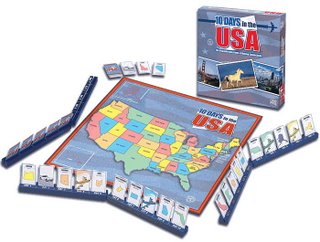This learning strategy has a couple of problems, however.
One is that Risk's “countries” are archaic and imprecisely defined. The game's Siam is our Thailand. The game treats Yakutsk, Irkutsk, and Siberia like three countries, but—if I understand rightly—Yakutsk and Irkutsk are actually a city and a territory within Siberia, which is a region within Russia.
Another problem is that Risk merges countries into convenient regions. On that embarrassing day in high school when I was unable to locate France on a world map, I really did know the location of Western Europe, a Risk "country."
Nathaniel's at the age where he would love Risk, and I wish the game were available with a map closer to the real world. Laying out all the countries of the Middle East as potential sites of conquest in an American board game might smack of imperialism, but it would be the most educational sort of imperialism.
Anyway, I don't believe all those hours of Risk ever infected me with a subconscious desire to colonize Irkutsk.
 Recently I had a chance to try an even better game, Ticket to Ride, at Geeks and Gamers. It's devilishly easy to pick up, but the longer I played, the more new strategies I discovered. I can't recommend it highly enough.
Recently I had a chance to try an even better game, Ticket to Ride, at Geeks and Gamers. It's devilishly easy to pick up, but the longer I played, the more new strategies I discovered. I can't recommend it highly enough.The object is to build railroads linking cities across North America. The board is a map of the United States and a bit of Canada, with several city names on it.
Nathaniel would love it, but I wish it worked with all 50 states instead of a handful of cities.
 Instead I bought 10 Days in the USA.
Instead I bought 10 Days in the USA.It didn't hook me at once like Ticket to Ride, but it's growing on me. It features a clearly labeled, brightly colored map of the United States. The object is to acquire 10 state cards that represent a 10-day "journey." That means adjacent cards have to be adjacent states. Some car and airplane cards are also included to let you work with states that aren't adjacent.
Playing the game with Camille has had a funny psychological effect on me. Now I feel a new affinity for states like Tennessee and Missouri, which border eight states each, but I'm uneasy about Maine—a state I used to like—which borders only New Hampshire.
10 Days in the USA seemed like an ideal teaching tool. Like Risk and Ticket to Ride, it teaches not only the names of places, but also their locations.
Unfortunately it's too hard for our kids. The box recommends it for children over ten. For children who are still struggling to locate the states and read their names, the rules and strategies are just too abstract.
The game board and the cards do provide a great tool set for creating our own educational games, however. What homeschooler wouldn't want a clear map of the United States with a corresponding set of color-coded state cards?
This morning the kids and I tried it with my own set of rules. Jessica won. They liked it. These are the rules we used.
10 Days in the USA—Little Kids' Rules
Objective
To acquire five state cards depicting adjacent states.
Setup
The Alaska and Hawaii cards are removed from the deck: these are not used. All the other cards are shuffled and left face down in a pile.
Play
Players take turns, beginning with the youngest.
A player begins his turn by picking 1 card and turning it face up in a common pile.
If the card is a car, the player discards it and picks 2 more cards instead.
If the player chooses, he can return any number of cards from his hand to the common, face-up pile.
If the player sees 2 or more face-up cards depicting adjacent states, he can choose to take those cards into his hand.
Play proceeds to the next player.
Rules
Airplanes are wild cards. An airplane can represent any state that is the same color as the airplane. For example, a yellow airplane could be used in place of Illinois or Utah.
The cards in the player's hand must always be contiguous so that you could draw a line through them without passing through any other states. For example, a player could have Illinois, Missouri, and Arkansas in his hand, but could never have Illinois, Missouri, and California in his hand.
The first player to acquire five adjacent cards (including any airplane wild cards) wins.
1 comment:
Granted it's a computer game, which may not be preferrable, but I loved Carmen Sandiego games when I was in elementary and really learned a lot about the US and the world from them.
Post a Comment